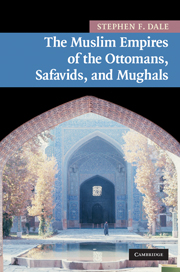Book contents
- Frontmatter
- Contents
- List of illustrations
- List of maps
- Preface
- Languages and transliteration
- Introduction
- 1 India, Iran, and Anatolia from the tenth to the sixteenth century
- 2 The rise of Muslim empires
- 3 The legitimacy of monarchs and the institutions of empires
- 4 The economies around 1600
- 5 Imperial cultures
- 6 Golden ages: profane and sacred empires
- 7 Imperial culture in the golden age
- 8 Quests for a phoenix
- Conclusion
- Glossary
- Dynastic lists
- Bibliography
- Index
5 - Imperial cultures
Published online by Cambridge University Press: 05 October 2014
- Frontmatter
- Contents
- List of illustrations
- List of maps
- Preface
- Languages and transliteration
- Introduction
- 1 India, Iran, and Anatolia from the tenth to the sixteenth century
- 2 The rise of Muslim empires
- 3 The legitimacy of monarchs and the institutions of empires
- 4 The economies around 1600
- 5 Imperial cultures
- 6 Golden ages: profane and sacred empires
- 7 Imperial culture in the golden age
- 8 Quests for a phoenix
- Conclusion
- Glossary
- Dynastic lists
- Bibliography
- Index
Summary
Introduction
In the Ottoman, Safavid, and Mughal empires rulers and their aristocratic elites patronized the major monuments and cultural activities that served simultaneously as emblems of their common civilization and as signs of their idiosyncratic regional cultures. Ottoman, Safavid, and Mughal rulers exhibited their membership in a common civilization when they built similar royal and religious architectural complexes in Bursa, Edirne, and Istanbul, Qazvin and Isfahan, and Agra and Delhi. These ensembles included the fortress or palace, the Friday or “cathedral” mosque, the bazaar, and often royal tombs; symbols, respectively, of sovereignty, religious affiliation, commercial interests, and dynastic prestige. Most of these men also applauded and rewarded poets who produced panegyric verse in their honor, as well as appreciating and writing lyrical poems that reflected a widely shared literary sensibility. With a few exceptions these monarchs supported elaborate imperial ateliers, whose artists produced brilliantly colorful paintings. Yet Ottoman, Safavid, and Mughal architects also designed stylistically unique buildings, while poets, whose literary culture was broadly shared across political boundaries, gradually came to adapt their verse to the peculiar linguistic and cultural circumstances of each empire, and miniature painters shaped a common artistic heritage to reflect the tastes and priorities of each court and society.
Architecture
Ottoman, Safavid, and Mughal architecture was functionally similar but stylistically distinct. Members of all three dynasties built on a grand scale in their capital cities and constructed similar architectural complexes that included four major types of buildings: dynastic or imperial structures – fortresses, palaces, and tombs – religious buildings – masjids and associated buildings such as maktabs or religious schools and madrasas, and sometimes Sufi khangahs – charitable institutions associated with Muslim piety – hospitals, public kitchens, and fountains – and commercial complexes – bazaars and caravansarais, which simultaneously fulfilled economic and religious functions.
- Type
- Chapter
- Information
- The Muslim Empires of the Ottomans, Safavids, and Mughals , pp. 135 - 176Publisher: Cambridge University PressPrint publication year: 2009



